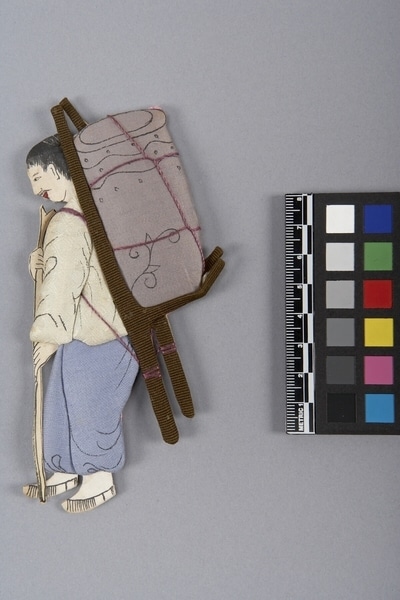Doll Item Number: Ed1.136 from the MOA: University of British Columbia

Description
Figure representing a person on a flat backing of white paper. Front view is depicted of the figure which is made of cloth lightly padded to give a three-dimensional effect having each portion made of a separate piece of cloth with painted details. Hands are made of paper. Face is made of white silk. Holding a long yellow paper stick which is forked at the top. Figure is carrying on the back, a brown frame of two vertical pieces (11.6 and 12 cm. long), each with a horizontal projection on which rests a grey bundle, 6.5cm. high, fastened with light burgundy-purple thread. Figure has hair in a topknot. Wearing a loose white shirt, loose blue cotton trousers, and sandals. Two pieces of white flannel hemmed with light red-pink silk thread are sewn to the paper backing.
History Of Use
Figure represents a lower-class Korean man of the late 19th century to early 20th centuries. The a-shaped frame was and is the common way for Korean men to carry heavy loads. Such figures were made during the time when Korea was first open to the outside world (after the mid 1890s), probably as gifts to present to missionaries or other visitors from foreign countries. Flat dolls like these were very popular during the period 1910-20. Before that time, shamans made dolls that they sold to their clients, as images of those the clients wanted to exorcise. Simple dolls were made of straw for children to play with. After Korea opened, people began to see dolls as artistic objects. They were made in workshops by masters, using authentic fabrics whenever possible, as their purpose was to introduce foreigners to Korean society.
Servants or ordinary people of the lower class did manual labour, such as carrying heavy loads. Pack frames were used to carry loads of many kinds of materials, including firewood, straw, cloth, and water. Water was carried in large ceramic containers, but liquids were also carried using a carrying pole instead of a pack frame. The forked staff “Ji-gae Da-ri” was used to support the pack frame when it was taken off.
Narrative
Collected by J. H. Morris while he was chief engineer for Seoul Railway, Korea.
Specific Techniques
The clothing was stitched around the edge and then a layer was added inside the clothing. Each section was separately applied and pasted in place. The details were finely painted.
Iconographic Meaning
The man’s topknot, “Sang-tu”, shows that he is married. The fabric of his clothes, western satin and fine cotton, shows that he is an ordinary person or a servant of the higher class, not a man of the lower class.
Item History
- Made in Korea during 1910
- Collected between 1910 and 1939
- Owned by Marion Stephan before August 1964
- Received from Marion Stephan (Donor) during August 1964
What
- Name
- Doll
- Identification Number
- Ed1.136
- Type of Item
- doll
- Material
- paper, silk fibre, cotton fibre, rayon fibre ?, paint and paste adhesive
- Manufacturing Technique
- spun, woven, cut, painted, sewn and pasted
- Overall
- height 14.4 cm, width 7.5 cm, depth 1.0 cm
Who
- Culture
- Korean
- Previous Owner
- Marion Stephan
- Received from
- Marion Stephan (Donor)
Where
- Holding Institution
- MOA: University of British Columbia
- Made in
- Korea
When
- Creation Date
- during 1910
- Collection Date
- between 1910 and 1939
- Ownership Date
- before August 1964
- Acquisition Date
- during August 1964
Other
- Condition
- good
- Current Location
- Case 77
- Accession Number
- 0113/0039